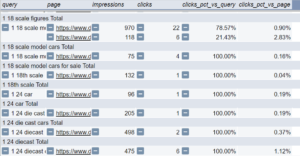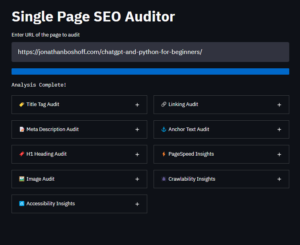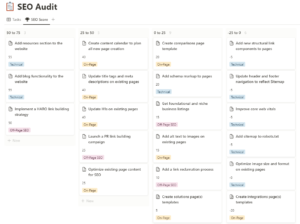In SEO, we are told to create “high-quality content”.
But what does that even mean?
This app helps demystify the extremely vague goalpost of “high quality”. It’s based on EEAT.
Experience. Expertise. Authority. Trust.
EEAT is what Google wants users to focus on to generate high-quality content that ranks well.
Try the app here: eeatchecker.com
How it works:
- Enter a URL and your email address
- Wait about 5 minutes
- Get an in-depth report emailed to you
Example outputs from the EEAT Checker
I tried this app on Campaign Monitor’s post: “How to improve email open rates“.
The app provides a three-section analysis.
- A high-level summary of findings for managerial types
- An actionable to-do list of EEAT improvements
- An in-depth breakdown of how well the page meets Google’s helpful content guidelines
High-level summary:

The output mentions the main things the report will focus on. In this case, examples, case studies, data, quotes, insights, and a few other improvements.
Actionable to-do list briefing:
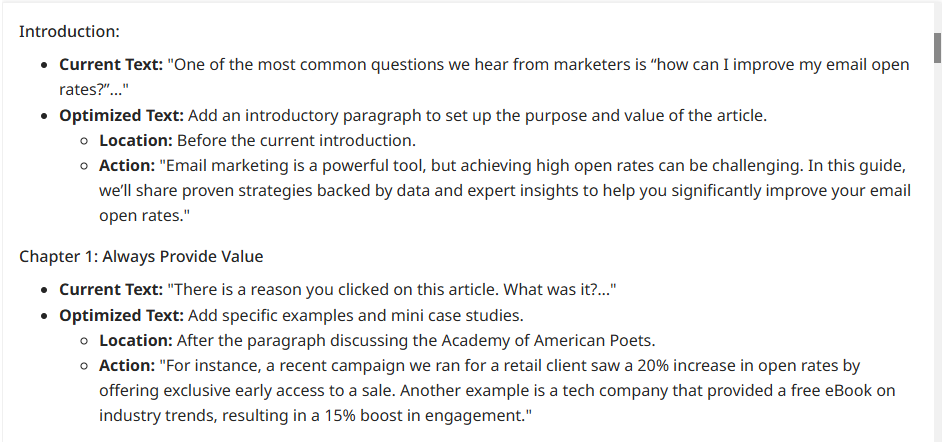
Outputs:
The app output will then point out every suggested improvement. It will selectively choose what to improve based on the URL you provide.
In my case, it provided one recommendation for each section of the page’s content.
For example, it suggests improving the introduction of answering commonly asked marketing questions. The improvement suggests hooking readers by mentioning proven strategies backed by data and expert insights to help significantly improve email open rates.
An intro like this would be a much more enticing hook to readers considering investing their time and effort into reading a long-from guide.
Eliminating fluffiness:
Then for the next section on always providing value. Instead of the current text about why the user clicked on the article in the first place, it suggests replacing that bit with a case study. It provides a fictional example for context. Like a 20% increase in open rates.
Before: Fluff, more fluff
After: What’s in it for you? Hook. Case study.
Seems on point!
The app continues to suggest 16 more improvement recommendations!
In-depth analysis of how well the page meets helpful content guidelines
If you keep scrolling through the recommendations, you’ll get to a section where the page is compared against Google’s helpful content guidelines.

In my example, when comparing the page content against Google’s recommendation toward providing original information, reporting, research, or analysis, it said the following:
“the tips are fairly generic best practices that can be found in many other email marketing articles”.
Ouch! Did I mention this page currently ranks #7 for its target keyword?
It also provides some tips to improve such as specific examples, case studies, real data from Campaign Monitor, or quotes from email marketing experts.
(All those tips are already included in the to-do list provided.)
Scrolling down in the report it also covers expertise. Stating the content is somewhat trustworthy but could include stronger evidence of expertise.

It suggests adding an author bio with credentials, quoting specific metrics and results from the author’s experience on improving open rates and citing external research or expert sources to back up key points beyond the one statistic provided on the page.
Disclaimer: The app can’t tell if there are links in the content because it only reads the plain text version of a page.
The app checked for 20 guidelines directly from Google on creating helpful, people-first content.
How to improve your page content to meet EEAT guidelines
You don’t need to incorporate every single recommendation this app provides.
Use it as a tool to make smart and insightful improvements to your content.
Pick the recommendations that resonate for you, and focus on those.
Some of them will require you to find actual research, insights, or quotes, which can be time-consuming.
It’s up to you to determine which recommendations are the best ones to incorporate.
Why does EEAT matter for SEO?
Many SEOs like to talk about how EEAT is not a ranking factor.
And that’s true, it’s not. EEAT is a pneumonic device used by search quality raters. These are people who get paid to evaluate search results and provide feedback.
Google focuses their quality rater’s reviews to review first-hand experience, expertise, authoritativeness, and trustworthiness. Their feedback is then used to modify their real ranking algorithms.
By optimizing content to improve EEAT, you’re future-proofing your pages, and making your content more valuable to readers.
Levels of EEAT and YMYL
Some content requires more EEAT than others. For example, a page about heart attacks needs to be super accurate and trustworthy. You only want to see accredited medical institutions on those SERPs.
High EEAT is needed for any YMYL topic (your money your life). Think investing, loans, finance, health, medicine, etc.
But for something less intense, like how to train your dog to sit, pretty much any dog owner would have enough experience or expertise to create an article on the topic.
Examples of EEAT ranking in the wild
I love to point out this example for the Wharton online MBA.
This is an online course from an accredited university that costs around $250k.
It’s a huge financial decision.
If you search “Wharton online MBA review” in the US, the top ranking result is currently an article featuring 27 reviews from current students.

This result doesn’t have the best keyword usage, the most backlinks, or the highest domain rating.
It ranks because people click on this result more than the other ones. Google leans on user feedback like clicks as a heavy-weighting signal for rankings.
This page isn’t fancy. It’s user-generated content of people sharing their real, unaffiliated reviews of the program.
If you were about to drop $250k on your education, this is exactly the information you’d be looking for before applying.
This is a great example of first-hand experience winning the SERPs. That’s what people want with this search.
Next, let’s look at “Is it safe to eat green potatoes”:
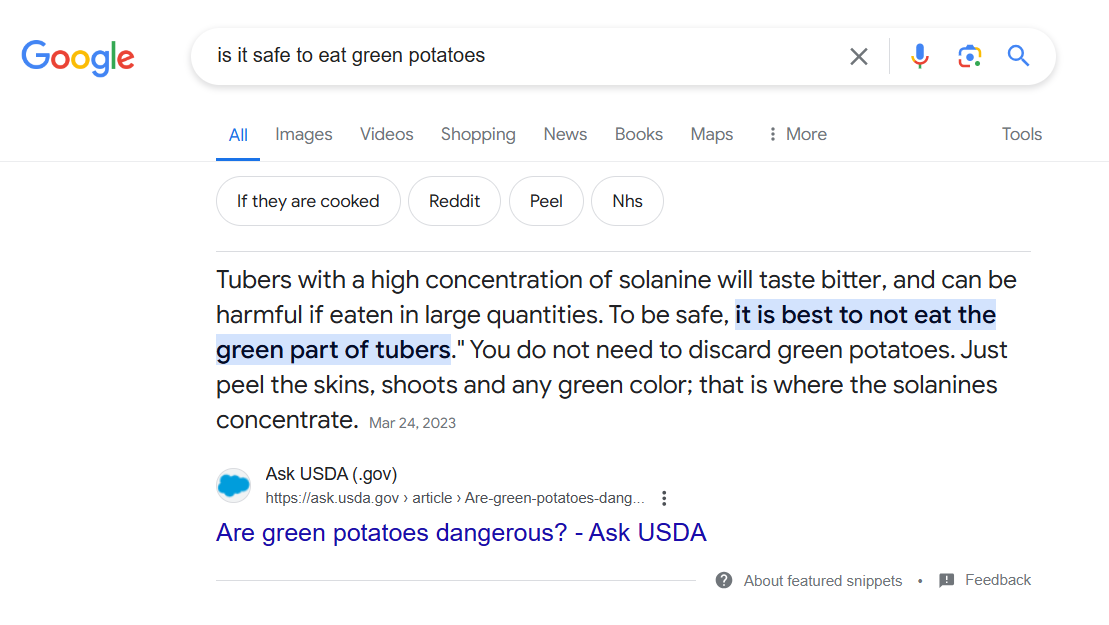
The top-ranking result is the USDA government site saying “No don’t eat them”. The United States Department of Agriculture is a highly authoritative and trustworthy source.
If they say don’t eat the green potatoes, no one questions it.
This is an example of Authority ranking because that’s what’s needed for this search.
While authority is much harder to replicate, it highlights the importance of becoming an industry leader in your space.
Your long-term goal should be to become the industry-leading authority for every topic on your SERPs.
This can be done practically by acquiring backlinks from the top websites in your space.
Here’s another one on “Lithium market trends”:

The top-ranking result is a research firm. They published insights from first-party data.
This is a search where a high level of expertise is needed to win. And the guys doing in-depth research are winning it.
If you do some digging, you’ll find that EEAT and top-ranking search results often go hand-in-hand.
Join The AI SEO Academy
Get access to the EEAT checker and more than 30 custom AI-powered SEO tools to help you streamline and automate your SEO.
Join the academy on Skool and dive in. You can try out all the apps I’ve built, and learn how to make your own.
